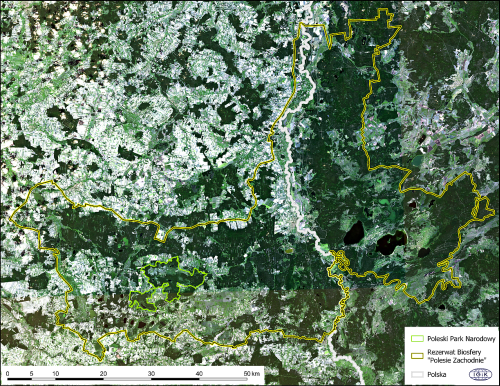Monitoring wetlands in the trans-boundary Biosphere Reserve West Polesie
Remote Sensing as a tool for monitoring of wetlands in the biosphere reserve "West Polesie"
Duration of the project: 1 December 2017 – 1 December 2018
Principle Investigators:
Dr. Eng. Agata Hoscilo (CT-IGIK), e-mail: agata.hoscilo@igik.edu.pl
Dr. Eng. Zinaida Niczyporowicz (National Academy of Sciences of Belarus), e-mail: nichiporovich_z@mail.ru
The main aim is to exchange experience and knowledge in the use of remote sensed satellite data and technology for monitoring of wetlands located in the transboundary region of Belarus and Poland.
Project objectives:
- to examine the use of the latest European satellites of a series of Sentinel satellites and constellation of the Belarusian-Russian satellites (BKA - Canopus) with a spatial resolution of 2.1m (panchromatic) and 10.5m (multispectral) for assessment of the current state and condition of wetlands in the Biosphere Reserve;
- to analysis land cover / use and land cover changes and to calculate the seasonal changes in soil moisture using radar Sentinel-1AB;
- to exchange knowledge and experience in data processing, analysis of satellite images and collecting field data using the state-of-the-art portable instruments;
- to organize two workshops integrated with the field visits at the wetland area in Poland and Belarus.
The project will be carried out in the wetlands area located in the transboundary biosphere reserve "West Polesie", which was established in 2011 under the international agreement. This reserve includes three valuable natural complexes: Western Polesie (Poland), Pribuzhskoye Polesie (Belarus) and Szacki (Ukraine) – transition area of about 140 thousand hectares. In 2012, the transboundary biosphere reserve "West Polesie" has been certified by UNESCO in the framework “Man and the Biosphere Programme”, which requires an active protection and conservation of the nature resources and additionally attracts tourists to visit the reserve. West Polesie plays a critical role at the juncture of biogeographic regions, migrational pathways, and cultural landscapes.
The largest part of the biosphere reserve is occupied by the Poleski National Park (Poland), in which a significant part is covered with swamps and peat bogs. The ecosystems of swamps and peat-bogs, which dominate the park’s landscape, are considered very delicate and can easily be influenced by outside factors. Some unfortunate changes were made by draining swamps.

Biosphere Reserve “West Polesie” overlaid on the Sentinel-2 image 30-08-2017.
